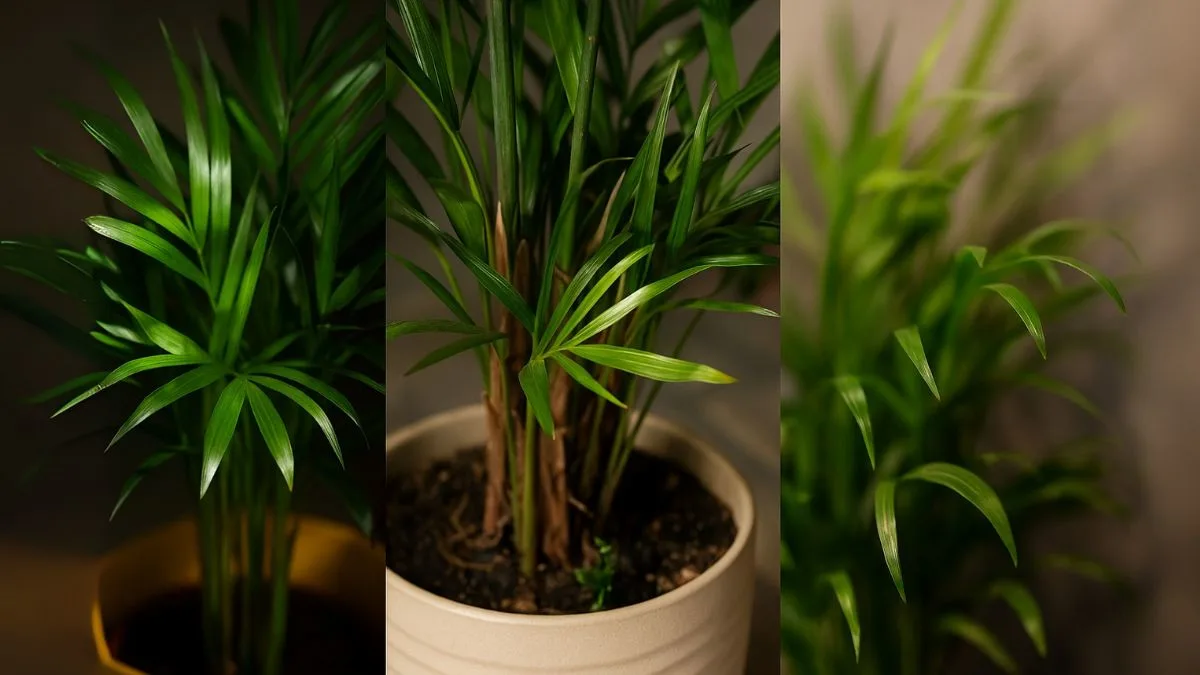ihe Bamboo Palms, also known as Chamaedorea seifrizii, is loved worldwide for its graceful, feathery fronds and air-purifying qualities. Whether you live in Canada, the USA, or elsewhere, it’s one of the most popular houseplants. But here’s the catch: many plant parents complain their bamboo palm turns yellow, wilts, or just refuses to thrive indoors.
If you’ve been in that situation, don’t worry. I’ve killed my fair share of palms before learning exactly what they need. This guide will highlight the most common mistakes and simple fixes to help your plant flourish.
Mistake #1: Overwatering and Improper Watering

One of the biggest killers of bamboo palms is improper watering. These plants like consistency, but they hate soggy roots.
- Overwatering leads to root rot and yellowing fronds.
- Underwatering causes dry, crispy tips.
The right method? They prefer bright, indirect light and should be watered regularly, but only when the top inch of soil feels slightly dry. Use your finger to check before every watering. And remember—always ensure you’re giving it good quality water, like filtered or rainwater, to avoid chemical build-up from tap water.
Mistake #2: Wrong Light Conditions
If your bamboo palm looks leggy or pale, lighting may be the culprit.
- Bamboo palms can’t survive in direct sunlight. The leaves scorch quickly when exposed to harsh rays.
- On the flip side, too little light can stunt growth.
The solution? Place the plant in bright, indirect light. A spot near an east- or north-facing window usually works best.
Also Read: The Right Way to Prune Tomato Plants for Maximum Harvests
Mistake #3: Using the Wrong Soil
Soil choice plays a huge role in plant health.
- These palms need soil-based potting compost that drains well while holding enough moisture.
- Many gardeners improve drainage by adding a handful of perlite to regular store-bought potting soil.
This mix helps roots breathe while preventing compaction. Trust me, after I repotted mine with perlite, it perked up within weeks.
Mistake #4: Ignoring Humidity
Another overlooked factor is humidity. Dry indoor air, especially in heated or air-conditioned rooms, stresses palms.
When providing insufficient light is combined with poor humidity levels, your palm becomes more vulnerable to pests and brown leaves. A humidity tray, grouping plants together, or using a humidifier can solve this.
Mistake #5: Pest Infestation
Like many houseplants, bamboo plants, namely the parlor palms, are susceptible to pests indoors. Spider mites, mealybugs, and scale insects are common culprits.
Check the undersides of leaves regularly and wipe them with a damp cloth. A mix of neem oil and water is a natural solution for infestations.
Also Read: How to Care for Orchids and Keep Them Blooming Year-Round
Ideal Care Routine for Bamboo Palms
Here’s a summary table for quick reference:
Requirement |
Best Practice |
Light |
Bright, indirect light |
Watering |
Regular, only when top inch is dry |
Soil |
Soil-based potting compost + perlite |
Humidity |
Moderate to high |
Temperature |
65–80°F (18–27°C) |
Water Quality |
Ensure you’re giving it good quality water |
Personal Experience: How I Revived My Dying Palm
A year ago, my bamboo palm looked miserable—droopy leaves, brown tips, and barely growing. Later I realized I had been guilty of overwatering and using compacted soil.
I repotted it with soil-based potting compost, added perlite, and placed it near a window with bright, indirect light. I also switched to filtered water. Within two months, new green fronds appeared. The transformation was proof that small corrections make a huge difference.
Why Bamboo Palms Are Worth the Effort
- They add tropical charm to any space.
- Excellent air purifiers, removing toxins like benzene and formaldehyde.
- Pet-friendly compared to other palms.
- They adapt well to indoor conditions when given the right care.
With a little attention, they’ll reward you with lush greenery that thrives year-round.
Also Read: Why You Should Grow a Pomegranate Plant in Your Garden
Conclusion
If you can’t keep your bamboo palm alive, the problem is likely one of four things:
- Overwatering, providing insufficient light, having poor humidity levels, or using the wrong soil.
- Remember, bamboo palms can’t survive in direct sunlight.
- Use soil-based potting compost, improve it by adding a handful of perlite, and water with good quality water.
- Keep them in bright, indirect light and monitor humidity.
By avoiding these mistakes, you’ll transform your struggling palm into a thriving, elegant centerpiece of your home.
👉 Ready to rescue your bamboo palm? Start with these small changes today, and watch your plant bounce back to life!






